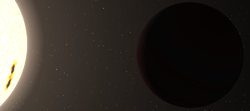WASP-4

| Observation data Epoch J2000.0 Equinox J2000.0 | |
|---|---|
| Constellation | Phoenix[1] |
| Right ascension | 23h 34m 15.0857s[2] |
| Declination | −42° 03′ 41.048″[2] |
| Apparent magnitude (V) | 12.468±0.025[3] |
| Characteristics | |
| Evolutionary stage | Main sequence |
| Spectral type | G7V[4] |
| Apparent magnitude (V) | 12.468±0.025[3] |
| Apparent magnitude (B) | 13.216±0.020[3] |
| Variable type | Planetary transit variable[4] |
| Astrometry | |
| Radial velocity (Rv) | 57.61±0.76[2] km/s |
| Proper motion (μ) | RA: 9.950(12) mas/yr[2] Dec.: −87.620(10) mas/yr[2] |
| Parallax (π) | 3.6623±0.0147 mas[2] |
| Distance | 891 ± 4 ly (273 ± 1 pc) |
| Details | |
| Mass | 0.899+0.033 −0.031[5] M☉ |
| Radius | 0.9150+0.0089 −0.0091[5] R☉ |
| Surface gravity (log g) | 4.472+0.013 −0.012[5] cgs |
| Temperature | 5488+29 −28[5] K |
| Metallicity [Fe/H] | −0.050±0.040[6] dex |
| Rotation | 22.2±3.3[6] days |
| Rotational velocity (v sin i) | 2.2+0.6 −1.0[6] km/s |
| Age | 7.0±2.9[6] Gyr |
| Other designations | |
| 1SWASP J233415.06-420341.1, TOI-232, TIC 402026209, WASP-4, TYC 8017-108-1, 2MASS J23341508-4203411[7] | |
| Database references | |
| SIMBAD | data |
| Exoplanet Archive | data |
WASP-4 is a G-type main-sequence star approximately 891 light-years away in the constellation of Phoenix.[4][1][2] Despite its advanced age, the star is rotating rapidly, being spun up by the tides raised by a giant planet on a close orbit.[8]
Planetary system
[edit]In 2007 the exoplanet WASP-4b was discovered orbiting this star. With an orbital period of just 1.3 days, it is classified as a hot Jupiter.[4] The planet's orbital period appears to be decreasing at a rate of 7.33±0.71 milliseconds per year, suggesting that its orbit is decaying, with a decay timescale of 15.77±1.57 million years. Another superjovian planet in the system is suspected.[9] The orbital decay was confirmed in a 2025 study.[5]
| Companion (in order from star) | Mass | Semimajor axis (AU) | Orbital period (days) | Eccentricity | Inclination | Radius |
|---|---|---|---|---|---|---|
| b | 1.200+0.032 −0.030 MJ | 0.02294+0.00028 −0.00026 | 1.338230994(84) | 0.0013+0.0005 −0.0009 | 88.05+0.85 −0.53° | 1.349+0.011 −0.012 RJ |
| c (unconfirmed) | ≥5.47±0.44 MJ | 6.82±0.25 | 7001.0±6.6 | — | — | — |
See also
[edit]References
[edit]- ^ a b Roman, Nancy G. (1987). "Identification of a constellation from a position". Publications of the Astronomical Society of the Pacific. 99 (617): 695. Bibcode:1987PASP...99..695R. doi:10.1086/132034. Constellation record for this object at VizieR.
- ^ a b c d e f Vallenari, A.; et al. (Gaia collaboration) (2023). "Gaia Data Release 3. Summary of the content and survey properties". Astronomy and Astrophysics. 674: A1. arXiv:2208.00211. Bibcode:2023A&A...674A...1G. doi:10.1051/0004-6361/202243940. S2CID 244398875. Gaia DR3 record for this source at VizieR.
- ^ a b c Henden, A. A.; et al. (2016). "VizieR Online Data Catalog: AAVSO Photometric All Sky Survey (APASS) DR9 (Henden+, 2016)". VizieR On-line Data Catalog: II/336. Originally Published in: 2015AAS...22533616H. 2336. Bibcode:2016yCat.2336....0H. Vizier catalog entry
- ^ a b c d Wilson, D. M.; et al. (2008). "WASP-4b: A 12th Magnitude Transiting Hot Jupiter in the Southern Hemisphere". The Astrophysical Journal Letters. 675 (2): L113 – L116. arXiv:0801.1509. Bibcode:2008ApJ...675L.113W. doi:10.1086/586735. S2CID 10823235.
- ^ a b c d e f Baştürk, Ö; Kutluay, A. C.; Barker, A.; Yalçınkaya, S.; Southworth, J.; Barkaoui, K.; Wünsche, A.; Burgdorf, M. J.; Timmermans, M. (2025-06-17). "The Orbit of WASP-4 b is in Decay". Monthly Notices of the Royal Astronomical Society. arXiv:2506.15022.
- ^ a b c d Bonomo, A. S.; Desidera, S.; et al. (June 2017). "The GAPS Programme with HARPS-N at TNG. XIV. Investigating giant planet migration history via improved eccentricity and mass determination for 231 transiting planets". Astronomy & Astrophysics. 602: A107. arXiv:1704.00373. Bibcode:2017A&A...602A.107B. doi:10.1051/0004-6361/201629882.
- ^ "WASP-4". SIMBAD. Centre de données astronomiques de Strasbourg. Retrieved 2018-09-22.
- ^ Maxted, P. F. L.; Serenelli, A. M.; Southworth, J. (2015), "A comparison of gyrochronological and isochronal age estimates for transiting exoplanet host stars", Astronomy & Astrophysics, 577: A90, arXiv:1503.09111, Bibcode:2015A&A...577A..90M, doi:10.1051/0004-6361/201525774, S2CID 53324330
- ^ Turner, Jake D.; Flagg, Laura; Ridden-Harper, Andrew; Jayawardhana, Ray (2022), "Characterizing the WASP-4 System with TESS and Radial Velocity Data: Constraints on the Cause of the Hot Jupiter's Changing Orbit and Evidence of an Outer Planet", The Astronomical Journal, 163 (6): 281, arXiv:2112.09621, Bibcode:2022AJ....163..281T, doi:10.3847/1538-3881/ac686f, S2CID 245329747
External links
[edit]- "SuperWASP Homepage". Archived from the original on 2002-12-08. Retrieved 2008-07-02.
- "UK planet hunters announce three new finds" (PDF). 2007-10-30. Archived from the original (PDF) on 2008-05-16. Retrieved 2008-07-02.
